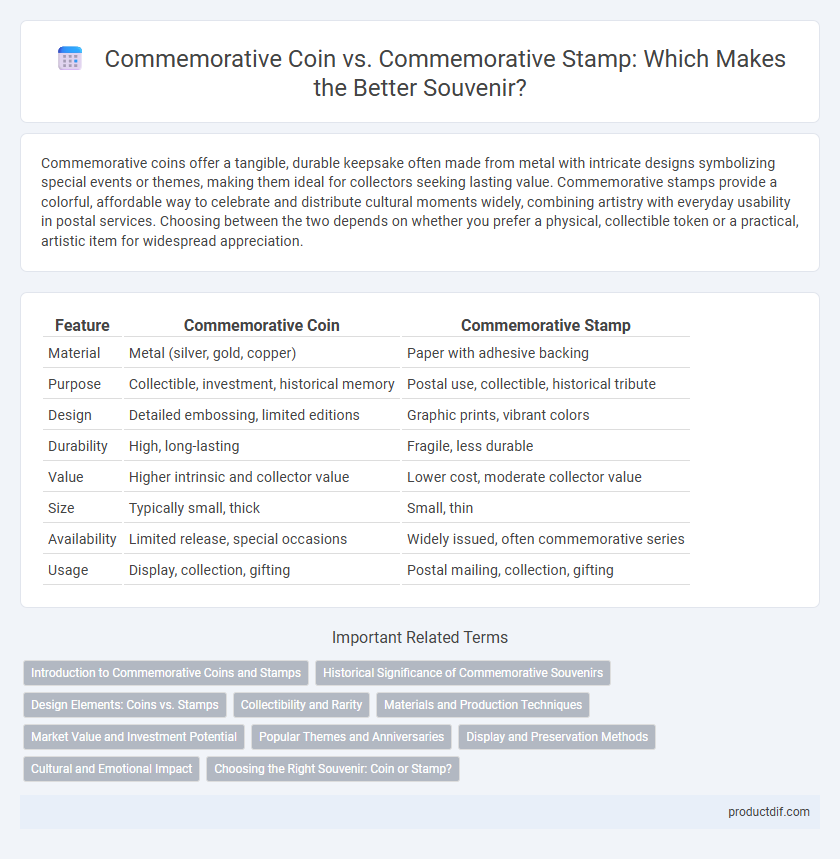Commemorative coins offer a tangible, durable keepsake often made from metal with intricate designs symbolizing special events or themes, making them ideal for collectors seeking lasting value. Commemorative stamps provide a colorful, affordable way to celebrate and distribute cultural moments widely, combining artistry with everyday usability in postal services. Choosing between the two depends on whether you prefer a physical, collectible token or a practical, artistic item for widespread appreciation.
Table of Comparison
| Feature | Commemorative Coin | Commemorative Stamp |
|---|---|---|
| Material | Metal (silver, gold, copper) | Paper with adhesive backing |
| Purpose | Collectible, investment, historical memory | Postal use, collectible, historical tribute |
| Design | Detailed embossing, limited editions | Graphic prints, vibrant colors |
| Durability | High, long-lasting | Fragile, less durable |
| Value | Higher intrinsic and collector value | Lower cost, moderate collector value |
| Size | Typically small, thick | Small, thin |
| Availability | Limited release, special occasions | Widely issued, often commemorative series |
| Usage | Display, collection, gifting | Postal mailing, collection, gifting |
Introduction to Commemorative Coins and Stamps
Commemorative coins and stamps serve as collectible souvenirs that celebrate significant events, achievements, or cultural heritage. Commemorative coins are specially minted pieces often made from precious metals and issued by official government mints, featuring intricate designs and limited circulation. Commemorative stamps, produced by postal authorities, highlight historical moments or notable figures and are valued for their artistic and philatelic significance.
Historical Significance of Commemorative Souvenirs
Commemorative coins and stamps serve as tangible reflections of significant historical events, with coins often marking national milestones or anniversaries through intricate designs and precious metals. These souvenirs capture cultural heritage by immortalizing images of leaders, landmarks, or pivotal moments, thereby fostering collective memory. Collectors and historians value commemorative coins for their durability and artistry, while stamps offer accessible snapshots of history through postal issuance, both reinforcing the preservation of historical narratives.
Design Elements: Coins vs. Stamps
Commemorative coins feature intricate relief designs with detailed engravings and metallic finishes that showcase texture and depth, often incorporating symbolic motifs and limited color palettes. Commemorative stamps highlight vibrant printed artwork with fine line work and multicolor palettes, allowing for intricate illustrations that celebrate cultural or historical themes on a small, flat surface. Both mediums serve as collectible souvenirs, yet coins emphasize tactile dimensions while stamps prioritize vivid visual storytelling through color and graphic detail.
Collectibility and Rarity
Commemorative coins often hold higher collectibility and rarity due to limited mintage, precious metal content, and intricate designs that appeal to numismatists. Commemorative stamps, while widely produced, gain rarity through errors, limited editions, and historical significance, attracting philatelists focused on unique variations. Both forms serve as tangible souvenirs, but coins generally command higher market value and long-term investment potential.
Materials and Production Techniques
Commemorative coins are crafted primarily from metals such as copper, silver, and gold using techniques like stamping and engraving to ensure durability and intricate designs. Commemorative stamps are produced on paper using advanced printing methods including photogravure and lithography, allowing vibrant imagery and fine detail. While coins emphasize metallic luster and tactile weight, stamps highlight color precision and surface texture through specialized inks and perforation.
Market Value and Investment Potential
Commemorative coins typically hold higher market value due to their precious metal content and limited mintage, attracting investors seeking tangible assets with intrinsic worth. In contrast, commemorative stamps offer broader accessibility and appeal to philatelists, but their investment potential is often more volatile and influenced by rarity and condition. Both souvenirs serve as historical collectibles, yet coins generally provide a more stable and appreciating asset class in the collectibles market.
Popular Themes and Anniversaries
Commemorative coins and commemorative stamps frequently celebrate popular themes such as historic events, national heroes, and cultural milestones, attracting collectors worldwide. Coins often mark significant anniversaries like centennials and bicentennials with detailed engravings, while stamps highlight diverse themes including wildlife, famous personalities, and global observances. Both souvenirs serve as tangible tributes, but coins emphasize durability and intricate craftsmanship, whereas stamps offer vibrant imagery and accessibility for everyday memorabilia.
Display and Preservation Methods
Commemorative coins are typically displayed in protective acrylic cases or velvet-lined boxes that prevent tarnishing and physical damage, making them ideal for long-term preservation. In contrast, commemorative stamps are often preserved using acid-free albums and protective sleeves that safeguard against moisture, sunlight, and handling wear. Both methods emphasize careful storage to maintain the collectible's condition and historical value over time.
Cultural and Emotional Impact
Commemorative coins possess a tangible cultural significance, often crafted with intricate designs that celebrate historical events or national heritage, creating a lasting emotional connection through their physical presence. Commemorative stamps, meanwhile, serve as miniature artworks that circulate widely, fostering shared cultural memory and emotional resonance by reaching diverse audiences worldwide. Both souvenirs act as poignant reminders of cultural identity and collective sentiment, each evoking a unique form of appreciation through either collectible value or widespread accessibility.
Choosing the Right Souvenir: Coin or Stamp?
Choosing the right souvenir depends on personal taste and the significance of the event; commemorative coins offer tangible value with intricate designs and metal composition, often appealing to collectors and investors. Commemorative stamps, on the other hand, provide cultural and historical storytelling through detailed artwork and limited editions, attracting philatelists or those valuing postal heritage. Considering factors like portability, rarity, and long-term appreciation helps determine whether a coin or stamp better suits a meaningful keepsake.
Commemorative Coin vs Commemorative Stamp Infographic

 productdif.com
productdif.com